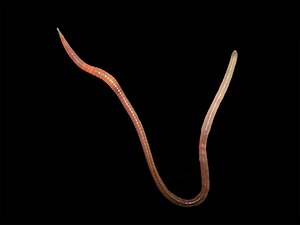Brush tail
| Brush tail | ||||||||||||
|---|---|---|---|---|---|---|---|---|---|---|---|---|

Pontoscolex corethrurus |
||||||||||||
| Systematics | ||||||||||||
|
||||||||||||
| Scientific name | ||||||||||||
| Pontoscolex corethrurus | ||||||||||||
| ( Johann Friedrich Theodor Müller , 1857) |
The brush tail ( Pontoscolex corethrurus ) is a type of little bristle from the family Rhinodrilidae (until 2012 counted to the Glossoscolecidae ) in the order of the Crassiclitellata (earthworms in the broader sense), which is native to the highlands of Guyana , but is now an invasive species in the tropics is common worldwide.
features
According to the original description by Fritz Müller, the brush tail has a rather slender, soft and easily tearing body with an almost colorless, translucent skin. That is why the body color is determined by the intestines and blood vessels and is therefore more reddish in front, more gray in the middle and pale reddish-white in the back. The animal has a cylindrical body which tapers towards the front from the clitellum , but remains about the same thickness from there towards the rear. A fully grown brush tail has around 200 to 250 ringlets, of which 13 ringlets sit in front of the clitellum and the clitellum itself occupies 8 ringlets. The foremost ringlet has longitudinal grooves, and when the head is stretched forward, two more front ringlets and a long-stalked, club-shaped head flap appear. The brush tail reaches a body length of 5 to 10 cm with a width of 3 to 4 mm and a body mass of 0.4 to 3.5 mg. In adult animals, at the end of the third quarter of the body length, there is a strongly perfused, strongly reddened area consisting of 5 to 10 narrow, bristle-free ringlets.
The segments of the brush tail are covered with numerous bristles, whereby these are more delicate and hook-shaped curved on the front part of the body as well as in 4 pairs, while at the back they are very strong, straight and amber-colored, stand in 16 rows on bumps and not completely withdrawn can be. Because of these dense bristles at the tail end of the annelid worm, Fritz Müller gave it the German name "brush tail".
Distribution, habitat and way of life
Pontoscolex corethrurus is in the highlands of Guiana in the north of South America at home. Like other crassiclitellates, it is a soil dweller and substrate eater , digesting the organic components of the swallowed substrate and loosening and aerating the soil through its digging activity. According to Fritz Müller's description from 1857, the brush tail (at that time still Lumbricus corethrurus ) in Itajahy ( Santa Catarina ) in the south of Brazil is "the meanest of the local earthworms and can be found in almost every clod of arable land". Pontoscolex corethrurus can now be found in tropical regions around the globe, including Hawaii and some subtropical regions such as Florida . The most important transport factors for humans are the trade in plants and potting soil as well as the adherence of egg cocoons to the soles of shoes, whereby changes in the ecosystem by humans also have a favorable effect on earthworms. It is common in prairie soils and farmland, but is also found in primary forests. As a Eurocean species, it can tolerate different soil types, salt contents and soil moisture levels.
Development cycle
Pontoscolex corethrurus like all clitellata a hermaphrodite , copulate each other in the mating two individuals. It is, however, a real r-strategist who can also reproduce through parthenogenesis , i.e. with unfertilized eggs. It needs temperatures of 23 to 27 ° C for reproduction. With the help of the clitellum, it forms numerous colorless, shimmering, almost spherical egg cocoons, each containing no more than two young animals and weighing around 20 to 40 mg. It takes 20 to 40 days from the egg-laying to the hatching of the young worms. These quickly grow into adults in a fertile soil.
literature
- Fritz Müller: Lumbricus corethrurus [sp. nov.] (Müller, 1857). In: Max Schultze, Fritz Müller (1856): Contributions to the knowledge of land planariums according to information from Dr. Fritz Müller in Brazil and according to Dr. Max Schultze. Treatises of the natural research society in Hall 4 (1), pp. 19–38, 61–74, here p. 26f.
- Raphaël Marichal, Michel Grimaldi, Jérôme Mathieu, George G. Brown, Thierry Desjardins, Milton Helio L. da Silva, Catarina Praxedes, Marlucia Martins, Elena Velasquez, Patrick Lavelle (2012): Is invasion of deforested Amazonia driven by the earthworm Pontoscolex corethrurus by soil texture and chemical properties? Pedobiologia 55, pp. 233-240.
- Andressa Cristhy Buch, George G. Brown, Cintia Carla Niva, KD Sautterc, Klaus Dieter Sautter, Lúcio Fábio Lourençato (2011): Life cycle of Pontoscolex corethrurus (Müller, 1857) in tropical artificial soil. Pedobiologia 54, Supplement, pp. S19-S25.
- Emmanuel Lapied, Patrick Lavelle (2003): The peregrine earthworm Pontoscolex corethrurus in the East coast of Costa Rica. Pedobiologia 47, 471-474.
- Lise Dupont, Thibaud Decaëns, Emmanuel Lapied, Vincent Chassany, Raphaël Marichal, Florence Dubs, Mélanie Maillot, Virginie Roy (2012): Genetic signature of accidental transfer of the peregrine earthworm Pontoscolex corethrurus (Clitellata, Glossoscolecidae) in French Guiana. European Journal of Soil Biology.
- Raphaël Marichal, Alex Feijoo Martinez, Catarina Praxedes, Dario Ruiz, Andres F. Carvajal, Johan Oszwald, Maria del Pilar Hurtado, George G. Brown, Michel Grimaldi, Thierry Desjardins, Max Sarrazin, Thibaud Decaëns, Elena Velasquez, Patrick Lavelle (2010 ): Invasion of Pontoscolex corethrurus (Glossoscolecidae, Oligochaeta) in landscapes of the Amazonian deforestation arc. Applied Soil Ecology 46, pp. 443-449.